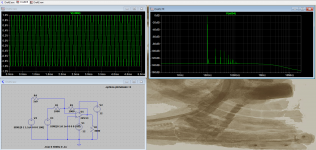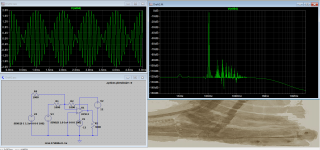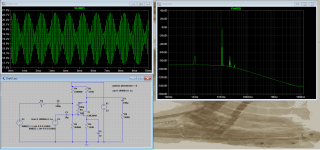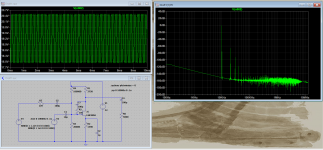Pass LabsAudio distortion and feedback - Pass Labs
The link above from Pass Labs say that high-gain NFB (such as Opamps) has lower distortions overall but the output harmonics are more complicated.
A simple triod although has high distortion but mostly 2nd and 3rd order.
I did two simulations using opamp and a simle JFET common emitter and the simulations show that: Opamp has lower overall distortions but it has more harmonics on the output.
On the IMD plot two 10Khz and 11KHz, there is only a single 1KHz on the simple FET, but on the opamp, there are several overtone of the 1KHz tone.
Because of that, opamp tends to sound lean and brittle due to the higher order harmonic.
The link above from Pass Labs say that high-gain NFB (such as Opamps) has lower distortions overall but the output harmonics are more complicated.
A simple triod although has high distortion but mostly 2nd and 3rd order.
I did two simulations using opamp and a simle JFET common emitter and the simulations show that: Opamp has lower overall distortions but it has more harmonics on the output.
On the IMD plot two 10Khz and 11KHz, there is only a single 1KHz on the simple FET, but on the opamp, there are several overtone of the 1KHz tone.
Because of that, opamp tends to sound lean and brittle due to the higher order harmonic.
The harmonic content of an overdriven tube amplifier consists primarily of 2nd order and 3rd order harmonics with some 4th order harmonics. The harmonic content of an overdriven transistor amplifier is primarily 3rd order with suppressed 2nd order harmonics. 2nd and 3rd order harmonics are the most important from a viewpoint of electronic distortion. Musically the 2nd harmonic is an octave above the fundamental and is almost inaudible, yet it adds body to the sound, making it fuller. The 3rd harmonic is a musical 12th. Instead of making the tone fuller, a strong 3rd harmonic makes the tone softer. The odd harmonics (3rd, 5th, etc.) produce a "stopped" or "covered" sound. The even harmonics (2nd, 4th, etc.) produce a "choral" or "singing" sound. Adding a 5th to a strong 3rd harmonic give the sound a metallic quality that gets annoying in character as the amplitude increases. A strong 2nd with a strong 3rd harmonic tends to open the "covered" effect. Adding the 4th and 5th harmonics to this gives an "open horn" character. The higher harmonics, above the 7th, give the tone "edge" or "bite."
Attachments
Last edited:



